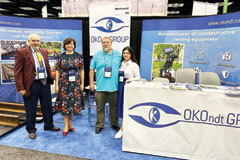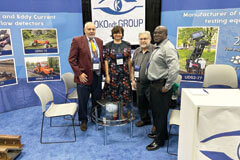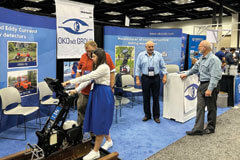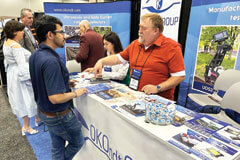The system is intended for the magnetic particle inspection of 55 dimension types of the rail transport 650-1300 mm diameter wheels for the surface and subsurface defects in any direction on all wheel surfaces, except for the hub inner hole surface.The system reset for the wheel specific dimension type is carried out for 30 min. The system is set up for the certain dimension type of the testing wheel by resetting the gibs in direction of the wheel, wheel oiling system, magnetization system and IF illumination system movement.
UMPK-1 is a semi-automated system with advanced technologies which make it possible to perform qualitative testing of the rail transport wheels by the magnetic and luminescent technique. The guaranteed testing efficiency – no less than 40 wheels per hour as long as the wheels are continuously loaded to the testing site. The wheel testing time without taking into account the time of loading-unloading on the testing site - no more than 1,5 min. The system can operate as an independent unit or can be integrated in the existing manufacturing lines of the customers' enterprises.
The system assures detection of the surface defects with the minimal conditional length 2 mm – on the finishing surface and 6 mm – on the roughly machined one (re-machined surfaces), such as "crack" of any direction with the opening width no less than 25 µm.
Main specifications:
- Wheel magnetic particle inspection techniques are performed in compliance with:
- GOST 21105 "Non-destructive testing. Magnetic particle technique".
- ISO 6933.
- PrEN 13262.
- DIN EN ISO – 9934 – 1,2,3.
- AAR M 107.
- testing of 55 dimension types wheels with the diameter from 650 to 1300 mm;
- system reset time for another dimension type – no more than 30 min.;
- wheel testing time – no more than 1,5 min.;
- testing efficiency: 40 wheels per hour;
- testing results documentation;
- possibility to integrate video surveillance system for remote control of the testing process.
The system carries out semi-automated magnetic and luminescent inspection of 55 dimension types wheels with the diameter from 650 mm to 1300 mm and testing velocity up to 40 wheels per hour. The system meets the requirements of such normative documents on magnetic particle inspection as GOST 21105, PrEN 13262, ISO 6933, ААR M107, DIN EN ISO-9934-1,2,3. Sensitivity conditional level of "B" system magnetic particle inspection - according to GOST 21105.
Structurally, "UMPK-1" system consists of the following component parts connected by one control system:
- Mechanical part.
- Computer system which, in its turn, consists of:
- - operators remote controls;
- - computing unit.
- the system of preparation and oiling with magnetic and luminescent suspension;
- wheel magnetization and demagnetization system;
- UV illumination system.
Main specifications of the system:
- Wheel magnetic particle inspection techniques are performed in compliance with:
- GOST 21105 "Non-destructive testing. Magnetic particle technique";
- ISO 6933;
- PrEN 13262;
- DIN EN ISO – 9934 – 1,2,3;
- AAR M 107.
- conditional sensitivity of "В" magnetic particle inspection according to GOST 21105;
- detection of the surface defects with the minimal conditional length 2 mm and opening width no less than 25 µm;
- testing of 55 dimension types wheels with the diameter from 650 to 1300 mm;
- system reset time for another dimension type – no more than 30 min.;
- wheel testing time – no more than 1,5 min.;
- testing efficiency: 40 wheels per hour;
- testing results documentation;
- possibility to integrate video surveillance system for remote control of the testing process.







